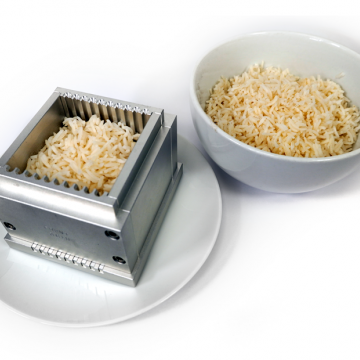
The texture of rice is vital to how the consumer perceives the quality of the product.
The Mecmesin Rice Texture Analyzer is a benchtop software-controlled system to evaluate the physical sensory properties of rice and other foods.
Fitted with a Kramer compression-shear fixture, the system replicates the natural bite and chewing action and the results correlate to the established texture profile attributes that align with mouthfeel, influencing perceived quality.
VectorPro software controls the Texture Analyzer to apply the forces on the test sample, acquires the data and automatically calculates the results which correlate to the correct physical organoleptic sensory qualities. Peak forces, average forces, work can all be calculated from the graphical results to indicate the essential texture quality attributes of the food. Terms such as hardness, stickiness, adhesiveness can be measured and compared to the ideal values, compared to other batches of supplied rice to optimise the cook profile of the product.

The texture of rice is vital to how the consumer perceives the quality of the product.
The Mecmesin Rice Texture Analyzer is a benchtop software-controlled system to evaluate the physical sensory properties of rice and other foods.
Fitted with a Kramer compression-shear fixture, the system replicates the natural bite and chewing action and the results correlate to the established texture profile attributes that correlate to mouthfeel, influencing perceived quality.
Example applications
 The Kramer Shear Cell tests rice in bulk to replicate bite and chew mouthfeel
The Kramer Shear Cell tests rice in bulk to replicate bite and chew mouthfeel Each test in each batch is clear shown in the results screen of VectorPro
Each test in each batch is clear shown in the results screen of VectorPro Rice batch sample and thin-blade shear cell fixture for firmness testing
Rice batch sample and thin-blade shear cell fixture for firmness testing Kramer thin-blade Shear Cell fitted to the interchangeable fixture base plate
Kramer thin-blade Shear Cell fitted to the interchangeable fixture base plate VectorPro will indicate peak values for firmness and other characteristics for the graphical data
VectorPro will indicate peak values for firmness and other characteristics for the graphical data The ISO Hardness value can be returned from selecting the constant resistance plateau of the curve
The ISO Hardness value can be returned from selecting the constant resistance plateau of the curve The sensory characteristic of stickiness is calculated from the return stroke of the shear cell
The sensory characteristic of stickiness is calculated from the return stroke of the shear cell VectorPro texture profile result calculation options include graph areas which can represent adhesiveness
VectorPro texture profile result calculation options include graph areas which can represent adhesiveness
Overview
The texture of rice is vital to how the consumer perceives the quality of the product.
The Mecmesin Rice Texture Analyzer is a benchtop software-controlled system to evaluate the physical sensory properties of rice and other foods.
Fitted with a Kramer compression-shear fixture, the system replicates the natural bite and chewing action and the results correlate to the established texture profile attributes that correlate to mouthfeel, influencing perceived quality.
VectorPro software controls the Texture Analyzer to apply the forces on the test sample, acquires the data and automatically calculates the results which correlate to the correct physical organoleptic sensory qualities. Peak forces, average forces, work can all be calculated from the graphical results to indicate the essential texture quality attributes of the food. Terms such as hardness, stickiness, adhesiveness can be measured and compared to the ideal values, compared to other batches of supplied rice to optimise the cook profile of the product.
Product brochures
Features
Key features
This system gives the rice producer a quantifiable method to benchmark and compare the texture of different rice varieties, optimize the cook profile (to indicate consumer preparation instructions) and check the consistency of supplied raw grains.
It can evaluate the impact of variations in harvesting, which affects the protein and carbohydrate levels in rice. These two characteristics have a great deal of influence on the final texture when it is prepared.
Software
VectorPro software controls the Texture Analyzer to apply the forces on the test sample, acquires the data and automatically calculates the results which correlate to the correct mechanical sensory qualities. The food scientist can examine the graph of force vs displacement and assign peak, average, areas and other values to texture property calculations.
Firmness
The peak compression force measured during the complete bite cycle represents the firmness. This indicates if the rice has been cooked enough.
Hardness
Similar to firmness, a sustained mean compression force measured during the complete bite cycle represents the hardness. This also indicates if the rice has been cooked enough and provides additional data to further characterise the texture.
Stickiness and Adhesiveness
As the shear blades return to the start of the cycle, the peak tension force indicates the stickiness in the cooked rice, correlating to the starch released during cooking. This texture may be desirable in some dishes. The mechanical texture parameter of adhesiveness is the work required to fully release the chewed material from the mouth and is calculated from the area under the curve. This attribute's levels range from sticky, a low-level value typically perceived as the ideal quality for cooked rice, to gluey, which is indicative of overcooking.

Got a question about a solution? Get in touch and speak to one of our Technical Sales Engineers now...







